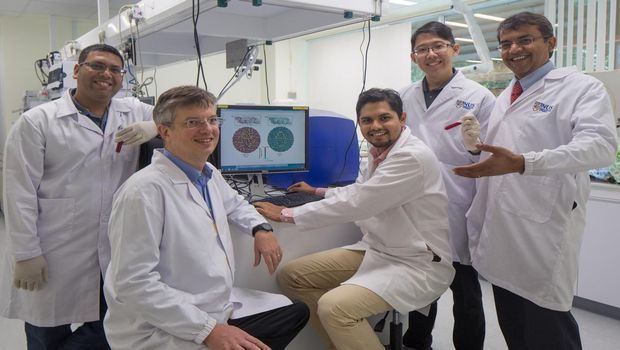NUS Scientists Discover Novel Vulnerabilities in Dengue Virus
A team of researchers from the National University of Singapore (NUS) has uncovered hidden vulnerabilities on the surface of the dengue virus. This novel discovery means that scientists can now develop strategies to target these weak spots for treatment of dengue, and possibly other closely related diseases like Zika, influenza and chikungunya.


A team of NUS researchers, led by associate professor Ganesh S. Anand from the Department of Biological Sciences at the NUS Faculty of Science (extreme right), has uncovered hidden novel vulnerabilities on the surface of the dengue virus. Courtesy of National University of Singapore
A team of researchers from the National University of Singapore (NUS) has uncovered hidden vulnerabilities on the surface of the dengue virus. This novel discovery means that scientists can now develop strategies to target these weak spots for treatment of dengue, and possibly other closely related diseases like Zika, influenza and chikungunya.
Led by associate professor Ganesh S. Anand from the Department of Biological Sciences at the NUS Faculty of Science, the nine-member research team published their findings in the prestigious scientific journal Nature Communications on 10 February 2017.
New treatment possibilities for the highly infectious and deadly disease
Dengue fever, caused by the dengue virus transmitted by the Aedes mosquito, is a serious global healthcare challenge which sees approximately 390 million infections annually. In Singapore, more than 13,000 people were infected in 2016, and nine deaths had resulted from the virus in that year. While a vaccine against the virus is recently available commercially, its effectiveness is limited as it is not effective against all the four dengue viral subtypes, and there are no alternative therapeutics yet.
To block the viral outbreaks, the NUS research team, which also comprises professor Thorsten Wohland, associate professor Lok Shee-Mei, Dr. Arun Chandramohan and Lim Xin-Xiang, sought to identify new approaches to tackle the dengue virus.
The team monitored the changes that the dengue virus undergo in three different conditions, namely: when it is inside the Aedes mosquito, when it is inside a healthy human, and when it is inside a patient suffering from dengue fever. When the dengue virus is transmitted to a healthy person, the change in the temperature of the host -- from 28 degree Celsius in a mosquito to 37 degree Celsius in a human body -- causes the virus to swell by 20 percent. This expansion exposes weak spots on the surface of the virus that were previously hidden.
Ganesh explained, "When the dengue virus is outside the human host, several of its surface regions are tucked away within a compact soccer ball-like arrangement. When the virus enters a human host, it senses an increase in temperature and puffs up to reveal new surfaces. This is a very exciting discovery as it offers numerous possibilities of designing therapies and vaccines to target these exposed surfaces to treat dengue as well as other related viruses such as Zika and chikungunya. Our team will be working towards this goal."
Source: National University of Singapore
IDEA in Action: A Strategic Approach to Contamination Control
January 14th 2025Adopting IDEA—identify, define, explain, apply—streamlines contamination control. Infection control professionals can mitigate risks through prevention, intervention, and training, ensuring safer health care environments and reducing frequent contamination challenges.
Balancing Freedom and Safety: When Public Health Mandates Are Necessary
January 9th 2025Public health mandates, such as lockdowns, masking, and vaccination, balance liberty and safety, ensuring critical protections during pandemics like COVID-19 while fostering long-term survival through science.
Long-Term Chronicles: Infection Surveillance Guidance in Long-Term Care Facilities
January 8th 2025Antibiotic stewardship in long-term care facilities relies on McGeer and Loeb criteria to guide infection surveillance and appropriate prescribing, ensuring better outcomes for residents and reducing resistance.
Considering Avian Flu: World Health Organization Expert Warns Against Raw Milk
January 6th 2025Drinking raw milk poses risks of disease transmission, especially with H5N1 outbreaks. Expert Richard J. Webby, PhD, advises against raw cow or goat milk consumption due to its unpredictable and significant risks.